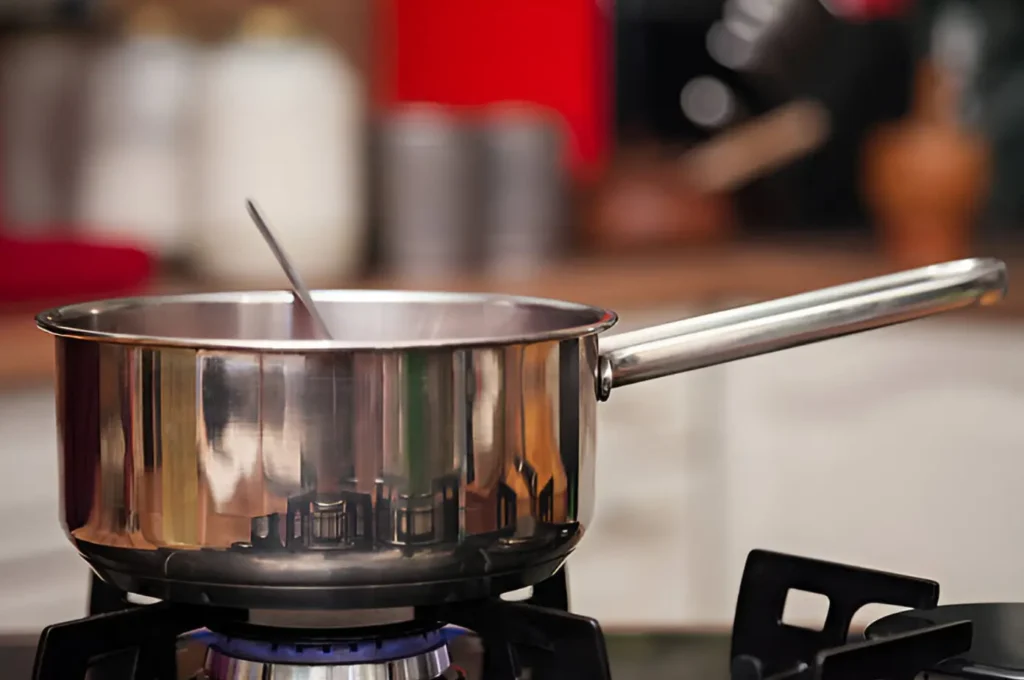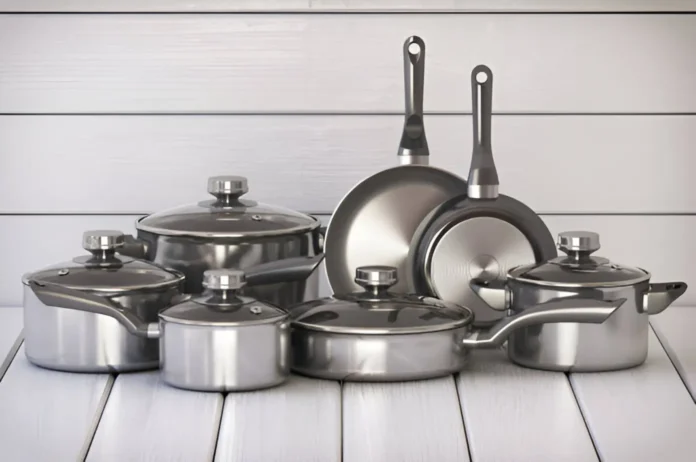When it comes to choosing the right cookware for your kitchen, stainless steel is often a top contender. Known for its durability and sleek appearance, stainless steel cookware offers a range of benefits, but it also has some drawbacks. Let’s explore why stainless steel is popular and what you should consider before purchasing it.
The Invention of Stainless Steel
Stainless steel was invented in the early 20th century as a solution to the problem of steel corrosion. In 1913, Harry Brearley, a British metallurgist working in Sheffield, discovered that adding chromium to steel made it resistant to rust and staining. While experimenting to create a corrosion-resistant gun barrel for the military, he found that steel with about 12% chromium was not only resistant to rust but also had a remarkable sheen.
Brearley’s discovery quickly found applications beyond military use. By 1924, stainless steel had become popular for cutlery, as its shiny surface and resistance to rust made it ideal for kitchen utensils. The material’s durability and resistance to acid made it a natural fit for cookware, and it soon became a staple in kitchens worldwide.
What is Stainless Steel Cookware?

Stainless steel cookware is made from a metal alloy consisting primarily of iron, with added chromium and nickel. These elements contribute to its rust-resistant and non-reactive qualities, making it ideal for kitchen use. The most common types of stainless steel used in cookware are 18/10 and 18/8, which indicate the ratio of chromium to nickel. The higher the nickel content, the more resistant the cookware is to rust and corrosion.
Health Benefits of Stainless Steel Cookware
- Non-toxic and Safe
Stainless steel is non-reactive, meaning it does not leach harmful chemicals into food, even when cooking acidic ingredients like tomatoes or citrus. This makes it a safer choice compared to some non-stick or aluminum cookware that can release toxins at high temperatures or when the surface is damaged. - Preserves Nutrients
Because stainless steel heats evenly, it allows for precise temperature control, which can help preserve the nutrients in your food. Overcooking and uneven heating can lead to nutrient loss, so using cookware that distributes heat well can contribute to healthier meals. - No Chemical Coatings
Unlike non-stick cookware, stainless steel does not have any chemical coatings that can wear off or release harmful fumes. This eliminates concerns about PFOA and PTFE, chemicals found in some non-stick coatings that may pose health risks.
Why Choose Stainless Steel Cookware?
- Durability
Stainless steel cookware is renowned for its strength and resilience. It can withstand high temperatures, resist scratching and denting, and maintain its shiny appearance for years. Unlike non-stick pans, stainless steel doesn’t have a coating that can chip or peel over time. This durability makes it a worthwhile investment, as it can last for decades with proper care. - Non-reactive Surface
One of the most significant advantages of stainless steel is its non-reactive nature. This means it won’t interact with acidic or alkaline foods, ensuring the flavors of your dishes remain pure. You can cook tomato sauces, citrus-based dishes, or anything else without worrying about the cookware affecting the taste. This is especially important for preserving the natural flavors and colors of delicate ingredients. - Even Heat Distribution
While stainless steel by itself is not the best conductor of heat, high-quality stainless steel cookware often features an Aluminium or copper core. This ensures even heat distribution, preventing hot spots and allowing for uniform cooking. Even heating is crucial for dishes that require precise temperature control, such as delicate sauces or perfectly seared meats. - Versatility
Stainless steel cookware is versatile and can be used on various heat sources, including gas, electric, and induction stovetops. It’s also oven-safe, making it ideal for recipes that require transitioning from stovetop to oven. This versatility allows for a wide range of cooking techniques, from sautéing and frying to baking and broiling. - Easy Maintenance
Cleaning stainless steel cookware is relatively simple. It is dishwasher-safe and resistant to stains and rust. With proper care, it retains its polished look without requiring special treatments. For stubborn stains or food residue, a mixture of baking soda and water or a stainless steel cleaner can restore its shine. - Professional Appearance
The sleek, polished look of stainless steel cookware adds a professional touch to any kitchen. Its timeless design complements any kitchen decor, from modern to traditional. Many chefs and home cooks prefer stainless steel for its aesthetic appeal and the confidence it brings to their culinary creations.
Drawbacks of Stainless Steel Cookware
- Cost
High-quality stainless steel cookware can be expensive, especially when it includes additional materials like copper or aluminum cores. While it is a worthwhile investment for many, the initial cost can be a barrier for some. However, cheaper options may not offer the same durability or heat distribution, so it’s important to weigh the cost against the benefits. - Weight
Stainless steel cookware is often heavier than other options like aluminum or non-stick pans. This can make it cumbersome to handle, especially for larger pots and pans. If you have difficulty lifting heavy cookware, consider pieces with ergonomic handles or opt for smaller sizes. - Stickiness
Unlike non-stick cookware, stainless steel can cause food to stick if not used correctly. Achieving a proper sear requires a bit of practice, such as preheating the pan and using adequate oil to prevent sticking. Developing the right technique can make a significant difference in your cooking experience. - Heat Conductivity
As mentioned earlier, stainless steel alone is not an excellent conductor of heat. Cookware without an aluminum or copper core might heat unevenly, leading to potential burning or uneven cooking. To ensure optimal performance, look for cookware with a multi-layered base that includes conductive materials. - Maintenance of Appearance
While stainless steel is generally easy to clean, it can develop water spots or discoloration if not dried properly after washing. Additionally, over time, the exterior may develop a patina, which is a natural result of use and exposure to heat. Regular cleaning and proper care can help maintain its appearance.
Tips for Using Stainless Steel Cookware
- Preheat Properly
To prevent sticking, always preheat your stainless steel pan before adding oil or food. This helps create a natural non-stick surface as the heat causes the metal to expand and contract slightly, reducing friction. - Use the Right Oil
Choose an oil with a high smoke point, such as vegetable oil or clarified butter, for searing and frying. This prevents the oil from burning and sticking to the pan. - Avoid High Heat
While stainless steel can withstand high temperatures, cooking on medium to medium-high heat is usually sufficient for most recipes. This helps preserve the pan’s finish and prevents food from burning. - Deglaze the Pan
After cooking, use a liquid such as wine, broth, or water to deglaze the pan. This loosens any stuck-on bits and adds flavor to your dish, making cleanup easier. - Avoid Abrasive Cleaners
Use gentle cleaning products and tools, such as a soft sponge or cloth, to avoid scratching the surface. For tough stains, a mixture of baking soda and water or a specialized stainless steel cleaner works well.
Where is Stainless Steel Cookware Most Popular?
Stainless steel cookware is widely used in professional kitchens and households around the world. Its popularity is particularly notable in the following regions:
- North America
- In the United States and Canada, stainless steel cookware is a staple in many kitchens due to its durability and versatility. Professional chefs and home cooks alike appreciate its ability to handle various cooking techniques.
- Europe
- European countries, especially those with a rich culinary tradition like France and Italy, often favor stainless steel for its classic appearance and reliable performance. It’s commonly used in both residential and professional kitchens.
- Asia
- In countries like India, stainless steel utensils and cookware are prevalent due to their durability and ease of maintenance. Stainless steel is also popular in China and Japan, where it is used for a wide range of cooking styles.
- Australia and New Zealand
- Stainless steel cookware is favored for its modern look and practical benefits, fitting well with diverse culinary practices and preferences.
Comparison with Other Cookware Materials
- Non-Stick Cookware
- Pros: Easy to clean, requires less oil for cooking.
- Cons: Less durable, coatings can wear off over time, potentially releasing harmful chemicals.
- Stainless Steel Comparison: Offers durability and safety without chemical coatings, though requires practice to prevent sticking.
- Cast Iron Cookware
- Pros: Excellent heat retention, natural non-stick properties when seasoned.
- Cons: Heavy, requires regular seasoning to maintain non-stick surface.
- Stainless Steel Comparison: Easier to maintain and more versatile for different cooking methods, though lacks cast iron’s heat retention.
- Aluminum Cookware
- Pros: Lightweight, good heat conduction.
- Cons: Reactive with acidic foods, prone to scratching.
- Stainless Steel Comparison: More durable and non-reactive, though heavier.
Environmental Impact
- Recyclability
- Stainless steel is 100% recyclable, making it an environmentally friendly choice for sustainable kitchens. Its long lifespan reduces the need for frequent replacements, minimizing waste.
- Sustainability
- Many manufacturers are adopting sustainable practices in the production of stainless steel cookware, including reducing energy consumption and minimizing waste.
How to Choose the Right Stainless Steel Cookware

- Check the Construction
- Look for cookware with multi-layered bases that include aluminum or copper cores for better heat distribution.
- Handle Design
- Opt for ergonomic, heat-resistant handles for comfortable and safe handling.
- Consider Your Needs
- Choose the size and type of cookware based on your cooking habits, whether you need a versatile skillet or a large stockpot.
- Budget Options vs. Premium Brands
- While budget-friendly options are available, investing in high-quality stainless steel cookware can offer better performance and durability.
Conclusion
Stainless steel cookware offers a range of benefits that make it a staple in many kitchens. Its durability, non-reactive nature, and versatility are significant advantages, providing a reliable and long-lasting solution for various cooking needs. However, its cost, weight, and potential stickiness might be drawbacks for some.
When choosing cookware, it’s essential to consider your cooking style and needs to determine if stainless steel is the right choice for you. Investing in high-quality stainless steel cookware can enhance your culinary experience and serve you well for years to come, making it a worthwhile addition to any kitchen.
Share Your Thoughts!
Share your thoughts and opinions in the comments below. Your feedback helps others make informed decisions and enriches our cooking community!



